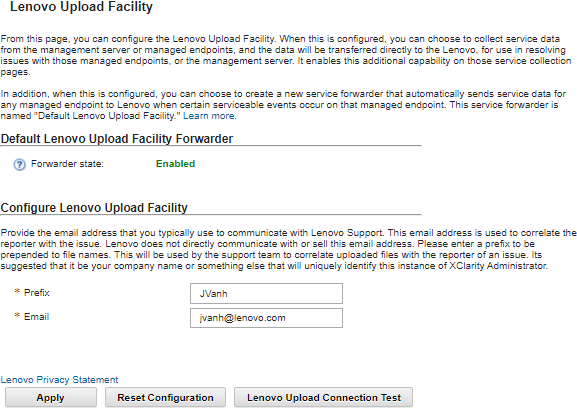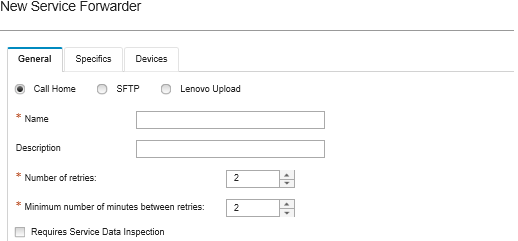Setting up automatic problem notification to the Lenovo Upload Facility
You can create a service forwarder that automatically sends service data for any managed device to your Lenovo service technician using the Lenovo Upload Facility when certain serviceable events, such as an unrecoverable memory, are received from specific managed devices so that the issue can be addressed. This service forwarded is named Default Lenovo Upload Facility.
Lenovo is committed to security. Your business data is never transmitted. Access to service data in the Lenovo Upload Facility is restricted to authorized service personnel.
Before you begin
Ensure that all ports that are required by Lenovo XClarity Administrator are available before you set up a service forwarder. For more information about ports, see Port availability.
Ensure that a connection exists to the required Internet addresses are required by the Lenovo Upload Facility. For information about firewalls, see Firewalls and proxy servers.
If XClarity Administrator accesses the Internet through an HTTP proxy, ensure that the proxy server is configured to use basic authentication and is set up as a non-terminating proxy. For more information about setting up the proxy, see Configuring network access.
About this task
A service forwarder defines information about where to send the service data files when a serviceable event occurs. You can define up to 50 service forwarders.
If a Lenovo Upload Facility service forwarder is configured but not enabled, you can manually transfer collected service files to the Lenovo Upload Facility at any time. For more information, see Submitting a service request for hardware issues to the Lenovo Support Center.
If a Lenovo Upload Facility service forwarder is configured and enabled, XClarity Administrator automatically collects service data and transfers the service file to the Lenovo Upload Facility when a serviceable event occurs so that the issue can be addressed.
For ThinkSystem V3 and V4 servers (with XCC2 or XCC3), XClarity Administrator saves service data in two files in the repository.- Service file. (.zip) This file contains service information and inventory in an easily readable format. This file is automatically sent to the Lenovo Upload Facility when a serviceable event occurs.
- Debug file. (.tzz) The file contains all service information, inventory, and the debug logs for use by Lenovo Support. You can manually send this file to Lenovo Support if additional information is needed to resolve an issue.
For other devices, XClarity Administrator saves service data (including service information, inventory, and debug logs) in a single service file in the repository. This file is sent to the Lenovo Upload Facility when a serviceable event occurs.
Procedure
Complete the following steps to setup a service forwarder for the Lenovo Upload Facility.
Setup a service forwarder to Lenovo Upload Facility for all managed devices:
From the XClarity Administrator menu bar, click .
Click Lenovo Upload Facility in the left navigation to display the Lenovo Upload Facility page.

Enter the email address and URL that was provided to you by Lenovo Support.
Click Apply.
A service forwarder named
Default Lenovo Upload Facility
is created for all managed devices using the specified contact information.Enable and test the
Default Lenovo Upload Facility
service forwarder.Click Service Forwarders in the left navigation to display the Service Forwarders page.
Select Enable in the Status column for the
Default Lenovo Upload Facility
service forwarder.Select the
Default Lenovo Upload Facility
service forwarder, and click Test Service Forwarders to generate a test event for the service forwarder and verify that XClarity Administrator is able to communicate with the Lenovo Upload Facility.You can monitor the test progress by clicking from the XClarity Administrator menu bar.
NoteThe service forwarder must be enabled before it can be tested.
Setup a service forwarder to Lenovo Upload Facility for specific managed devices:
- From the XClarity Administrator menu bar, click . The Service and Support page is displayed.
Click Service Forwarders in the left navigation to display the Service Forwarders page.
Click the Create Service Forwarder icon (
 ) to display the New Service Forwarder dialog.
) to display the New Service Forwarder dialog.Click the General tab.

Select Lenovo Upload for the service forwarder.
Enter the name of the service forwarder and a description.
Specify the number of automatic-notification retries. The default is 2.
Specify the minimum number of minutes between retries. The default is 2.
(Optional) Click Requires Service Data Inspection if you want to inspect the service files before they are transferred, and optionally specify the e-mail address of the contact to be notified when service files must be inspected.
Click the Specific tab, and fill in the email address and upload URL that was provided to you by Lenovo Support.
Click the Devices tab, and select the managed devices and resource groups for which you want this service forwarder to forward service data.
TipTo forward service data for all managed devices (current and future), select theMatch all devices checkbox. Click Create. The service forwarder is added to the Service and Support page.
On the Service and Support page, select Enable in the Status column to enable the service forwarder.
Select the service forwarder, and click Test Service Forwarders to generate a test event for each service forwarder and verify that XClarity Administrator is able to transfer to the Lenovo Upload Facility.
NoteThe service forwarder must be enabled before it can be tested.
After you finish
From the Service and Support page, you can also perform the following actions:
If Requires Service Data Inspection is selected and a serviceable event was received from one of the managed devices that is associated with the service forwarder, you must inspect and service files before the files are forwarded to the service provider. For more information, see Inspecting service files.
Modify the service-forwarder information by clicking Service Forwarders in the left navigation and clicking the Edit Service Forwarder icon (
 ).
).Enable or disable a service provider by clicking Service Forwarders and selecting Enable or Disable in the Status column.
Delete the service provider by clicking Service Forwarders and clicking the Delete Service Forwarders icon (
 ).
).Collect service data for a specific device by clicking Endpoint Actions in the left navigation, selecting the device, and then clicking the Collect Service Data icon (
 ). For more information, see Collecting and downloading service data for a device.
). For more information, see Collecting and downloading service data for a device.